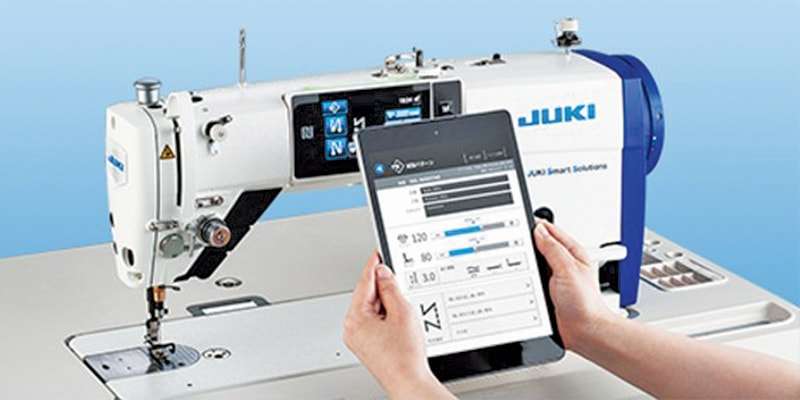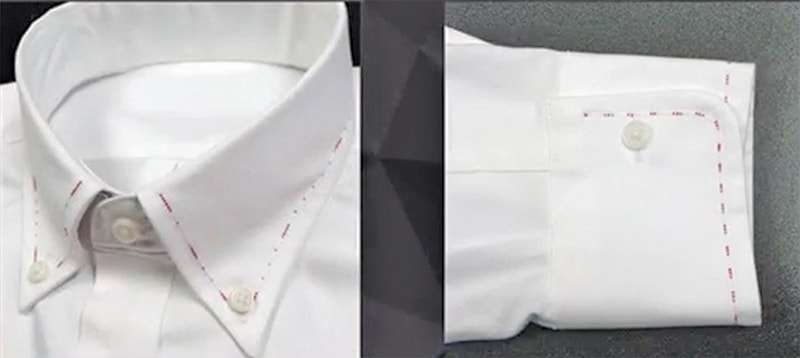
During a technology fair, the sewing machine manufacturers try to come up with impressive new features to attract buyers. While the automation-related innovations are shown in exhibitions in developed markets like US and Europe, quality- and productivity-related innovations are shown in exhibitions for developing markets like Asia. Ever since Brother displayed S-7300A lockstitch machine two years ago, there has been a mixed response from users, if not overwhelming. However, probably assessing the immense value it can deliver, the competition which many other sewing machine manufacturers such as TYPICAL, Juki and Duma face, has made them to come up with similar features. But what is actual innovation and what value the machine can actually deliver? Dr. Prabir Jana, NIFT Delhi writes based upon his detailed analysis of different brands…
My first encounter with Brother S-7300A was in an Indonesian factory way back in June 2015. The company had installed a complete line (as pilot experimentation) and it was touted as the future of sewing machines, capable of automatic real time data collection. Even after continuous probing with the technical heads, no further features attracted my attention. It was only in 2016 that Brother displayed S-7300A for the first time in India and the core feature of the machine portrayed was the digital feed system besides few other value features. At GTE ’17, Juki’s DDL-9000C, TYPICAL’sGC6930A, and Duma’s DM1969M were rubbing their shoulders with Brother’s S-7300A.

What is digital feed and what value it can give to manufacturers?
Typically any industrial sewing machine has one motor which drives its main shaft and which subsequently drives other parts of the sewing machine like needle bar, take up lever, feed dog and hook shaft. In digital feed machine, the feed dog movement is separated from the main drive and a distinct stepper motor independently drives the feed dog. Freeing up the feed dog movement from the needle movement offers tremendous possibilities which are as follows:
1. Precise reverse feeding.
2. Design stitching.
3. Simultaneous condensed and backtack on the same seam.
As the stepper motor control the feeding motion, it can achieve precise feed stroke, thereby enabling high quality back reverse sewing. While the stitch condensation and back tack with clever change of stitch length is done simultaneously on the same seam, it generates a design stitch, which was possible by hand only before. Variety of looks can be created by micro millimetre length forward stitch combined with long length of reverse stitch. Further, thanks to the electronic feeding system, the mechanical adjustment is no more required.

Although these seemingly advantageous setting of different feed locus likely to solve feeding problems of different types of fabric material, there is lack of clarity about what feed type should be used in what situation? All the brands loosely talk about solving problems like puckering, feeding and ply slippage, etc., however clear guidelines and ready reference is required for the manufacturers to use the feature effectively. Most surprisingly, none of the brand’s technical persons have a clear idea about what exact phenomena these different feed types are going to create and thus solve resulting problems. Juki leaflet mentions that the front rise feed is going to reduce uneven material feed, while back rise feed is going to prevent needle bending, a completely different problem rather than fabric feeding problem. It also specifies that the rectangular box feed is meant for sewing multilayered section, but it is not clear whether it is for crossover seams or not. Similarly it states that the feed dog does not protrude the top surface of throat plate when the sewing machine stops with its needle bar up, thereby facilitating placement/removal of the material on/from the top surface of throat plate and preventing the material from being damaged by the feed dog.
These models by different brands also provide prevention of clogging stitch at crossover seams. The machine comes with automatic material thickness sensor (integrated with needle bar), which detects the change of thickness while sewing, and accordingly lowers the presser foot and slows down the speed helping it to reduce the clogging of stitch at cross over seam and needle breakage.
Another very important benefit arising out of digital feed is compensation stitch with half-length stitch mechanism. When sewing corner stitch with comparatively higher stitch length, sometimes there are requirements of lesser stitch length to align at the corner. The half-stitch mechanism will enable this to happen very easily with just the press of a button. Moreover, the reverse stitch button is also conveniently placed near the needle, which was earlier done with the reverser lever located at the right side of the machine head.
One more seemingly useful feature highlighted by all brands is ultra-short thread trimming and prevention of bird’s nest problem. While the bird’s nest problem is an old one since the inception of UBT feature, the problems are addressed by multiple improvements. Juki reasons out that the thread trimming is carried out while the feed dog is lowered. As a result the clearance provided between the throat plate and the material is eliminated, thereby stabilizing the length of thread remaining after thread trimming. Brother mentions that the double action thread trimming mechanism by two moving knives cut the thread right under the needle hole, resulting in ultrashort remaining thread at minimum 3 mm.
The other features bundled into the discussed models are new hook set enhancing sewing capability for a wide range of materials, needle breakage prevention function, inbuilt LED light, active thread tension and USB port, although all the features are not available in all brands. Brother’s needle breakage prevention function prevents the needle breakage while stitching reverse with the help of patented actuator switch. The icing on the cake is definitely the IoT functions promised by all. While the Juki and Brother leaflet detail the IoT capability, TYPICAL and Duma do not mention any details. Juki and Brother offer transferring data on sewing machine adjustments made according to the product to be sewn to a commercially available Android tablet in contactless mode or over Wi-Fi. This enables quick check for uniform settings as well as confirmation of conditions of sewing machines in a sewing line, thereby facilitating setup changes.
Amidst the flurry of developments displayed by the four brands, some of the basic technologies are yet to be cleared to know the real benefits that can be accrued. While Brother model is equipped with only two separate motors, Juki, TYPICAL and Duma are presumably working with three-motor technology. Neither the technical executives nor the brochure is clear (while it is not clear as of now) about the separate functions of all three motors. It is assumed that one stepper motor control the feeding motion, the second stepper motor control thread trimming and presser foot lift and third stepper motor drives the main shaft controlling needle bar, take up lever and hook movement. Most interestingly, Duma also brought out submodels with needle feed mechanism while other three brands offer only drop feed mechanism. It also offers sub-models with thread catcher mechanism, once a mandatory feature in all UBT machines.
Conclusion
The stepper motor-driven hook shaft in bar tack machine was displayed by Tice Technology almost two decades ago and Brother was the first commercial adopter of the same technology. However, the development was not a commercial success. The current digital feed combined with multiple other features may hold the key to commercial success of digital feed technology now. Even though the digital feed offers several value-added features related to productivity and quality, the real benefit may be harnessed by its IoT (Internet of Things) capability. Brother experimented (will not call demonstrated, as it is still experimenting with features) the real time data collection from sewing machines to computer with its Wi-Fi features during GTE exhibition. Although data flow from sewing machine to computer is flawless, the data flow from computer to sewing machine is not yet established. The day is not far when one will be able to set the machine setting (like stitch length) in computer and the setting will be automatically transferred to all sewing machines seamlessly without any mechanic or operator intervention. This would be the real celebration of IoT in sewing machine…

Post a Comment